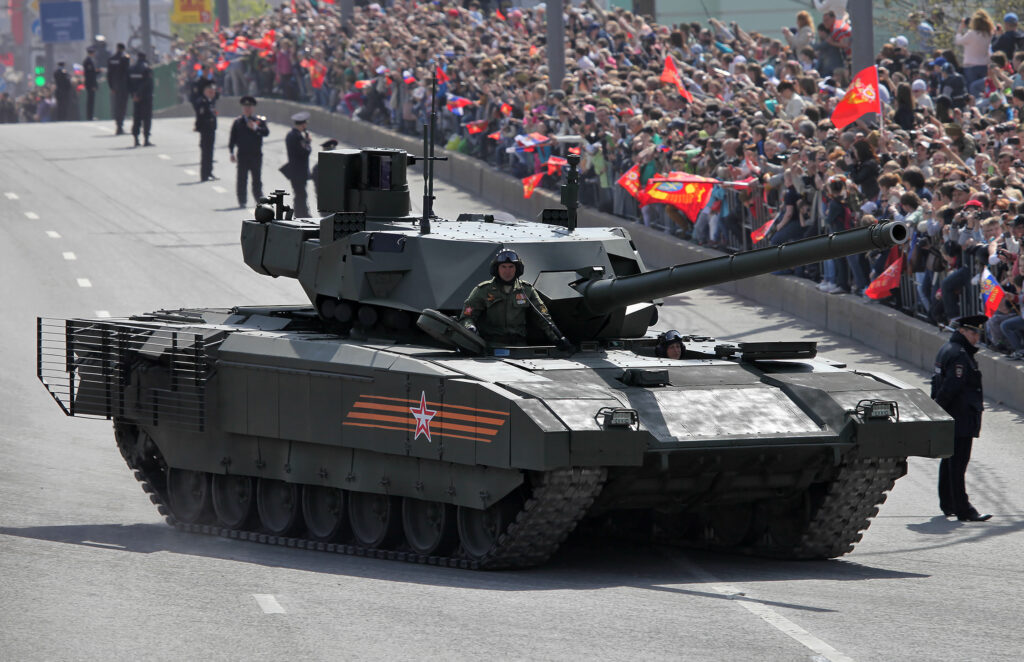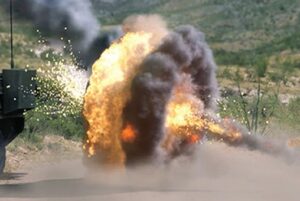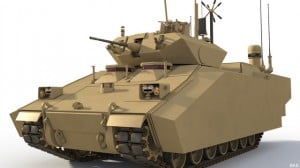
Russia’s new T-14 Armata tank on parade in Moscow. Russian advances are driving the Army to explore new combat vehicles.
HUNTSVILLE, ALA.: The year of decision for the Army’s nascent Next Generation Combat Vehicle will be 2022. That’s when “at least two” NGCV demonstrators get field-tested by real troops, officials told the Association of the US Army conference here today. What the soldiers learn will then help Army leaders’ decide whether to fund a full-up program to field a new armored vehicle by 2035, or put off a fresh start — again — and just keep updating 1970s designs.
There’s a long and painful history of cancelled Army programs to bear in mind, from the Comanche helicopter to the Crusader howitzer in 2002, to the Future Combat Systems vehicle family in 2009, to the Ground Combat Vehicle in 2014. Meanwhile, the M1 Abrams battle tank and M2 Bradley troop carrier designed in the 1970s have fought well for decades, and they’ve been repeatedly upgraded, almost beyond recognition, but there are limits to what an old design can do. With Russia deploying its latest hardware to devastating effect in Ukraine, many Army leaders fear — in the words of Lt. Gen. H.R. McMaster, now National Security Advisor — that “we are outranged and outgunned.”

Col. William Nuckols talks to a German army officer at AUSA in Huntsville.
Piecing together statements from several service officials today, it’s possible to put together the most detailed timeline I’ve seen for future armor. That includes not only the Next Generation Combat Vehicle, but a crucial supporting effort, work on Active Protection Systems (APS) to decoy, blind, or shoot down incoming anti-tank missiles — another technology Russian tanks use in Ukraine that we don’t have.
“Sometime this year,” the Army will establish Team NGCV, said Col. William Nuckols, director of mounted (i.e. vehicle) requirements at the Fort Benning Maneuver Center of Excellence. That will be a cross-functional “Integrated Concept Development Team” drawn from multiple disciplines to assess both the maturity of the technology and the implications across Army doctrine, organizations, training, and so on (DOTMLPF).
Next month, the Army will begin “characterization” of how three off-the-shelf Active Protection Systems work on the M1 tank, said Col. Kevin Vanyo, program manager for emerging capabilities at TARDDEC. (That’s the Army’s Tank-Automotive, Research, Development, and Engineering Center). Testing on the M2 Bradley and eight-wheel-drive Stryker will start soon after. Work on all three vehicles — about a $75 million effort all told — should be done about this time next year (specifically, the second quarter of fiscal year 2018).
“We have a decision point at the end of our characterization phase (in 2018),” Vanyo said. “Do we need something now… or are we just going to sit on this and wait until MAPS is here?”
MAPS is the Modular Active Protection System, the Army’s from-scratch effort to develop something more sophisticated and adaptable than the off-the-shelf APS that Vanyo is testing. A TARDEC briefer at AUSA said elements of MAPS will be tested on the Abrams and Bradley in 2018 and 2019.

Raytheon Quick Kill Active Protection System
Progress on active protection is critical for Next Generation Combat Vehicle. Since the British invented Chobham armor, a layering of metal and ceramic, in the 1960s, the weight required for a given level of protection has stayed roughly constant, and there is no imminent breakthrough in material science to change that equation. Heavier vehicles take more planes and ships to transport to the war zone; they require more fuel trucks and mechanics to keep moving on the battlefield. Those vulnerable fuel convoys suffered heavy losses in Afghanistan and Iraq, and the highly mobile tactics the Army envisions for a future Multi-Domain Battle may be impossible without vehicles that can go much longer before needing resupply. The best bet to make lighter, more fuel-efficient vehicles that can survive is Active Protection Systems.
That brings us back to the Next Generation Combat Vehicle. By 2022, contractors will build at least two tech demonstrators — less full-up prototypes than the armored equivalent of concept cars — and have them in the hands of real soldiers for evaluation.

BAE’s design for the cancelled Ground Combat Vehicle
“This is very flexible,” Nuckols said, “(but) we anticipate FY22 being when we decide whether or not we want to make NGCV a program of record and move forward, or take a pause (and) wait for the critical mass of technologies. (Whether) to invest that huge sum of money into a new program… will be based on the technologies that are available, the affordability of those technologies, and how can we integrate those into a platform that does the things we want it to do.”
If NGCV does become a program of record, the Army should have the first unit equipped in the early 2030s. The question’s often asked — including by Congress — “why are we waiting so long?” said Nuckols. “We could go faster. Once the technology demonstrators are completed, and we assess the technologies and we make some refinements to our requirements, we could go earlier.”
“We’re really looking at everything and trying to see where the sweet spot is, in terms of waiting for something to develop, and not waiting so long we’re left with 50-year old Bradleys and 50-year-old Abrams,” Nuckols said.
Global military spending hits ‘all-time high’ of $2.4 trillion: SIPRI report
The US remains the world’s largest defense spender, outlaying $916 billion last year, a 2.3 percent annual increase, ahead of China in second place, which spent an estimated $296 billion, a 6 percent increase over the same period.



























